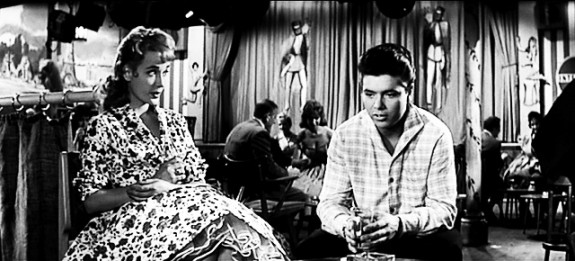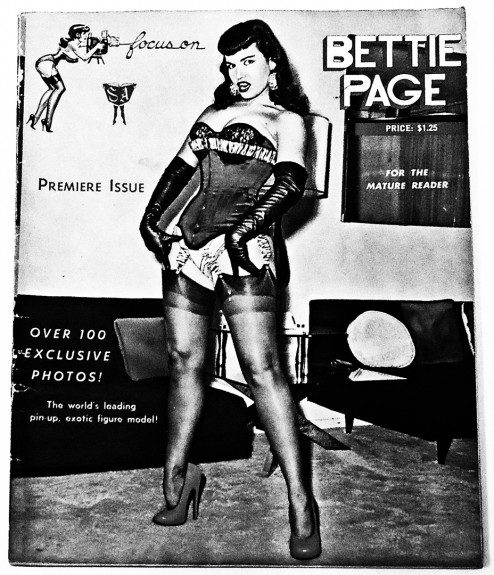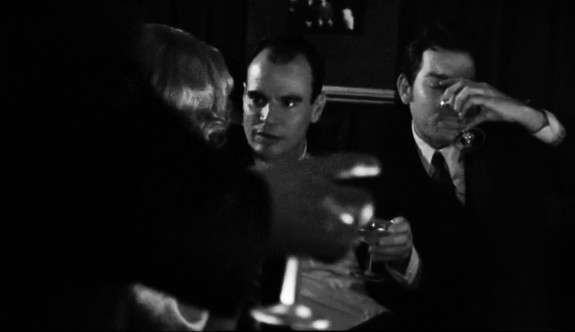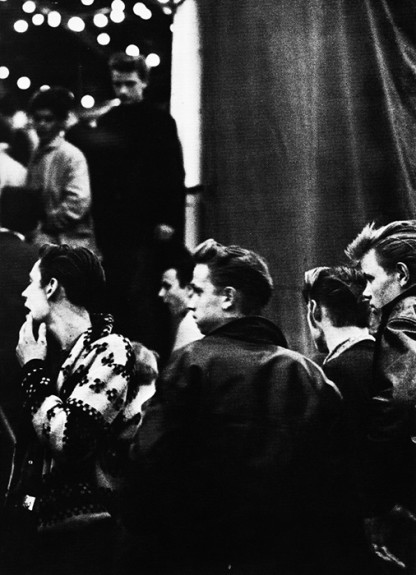Search For "pre swinging london"
-
A Vision Of Loveliness, pre-Swinging London glamour and tales of West End popsies
 A curious book Louise Levene’s A Vision Of Loveliness.
A curious book Louise Levene’s A Vision Of Loveliness.It begins like a humourous, if at times grim and snobbery bound, snapshot of a previous era in Britain’s history (the late 1950s/early 1960s to be precise) that is all kitchen sink-esque non-glamour and pre consumer choice/disposable incomes; condemned gas geysers, every meal tipped out of a can, twitching curtains and conformity, dead-end jobs and maybe one good suit or outfit to wear if you’re lucky.
It is a tale that is played out in a time before the true explosion of teenage tastes, styles and money to throw at fashion and fripperies; a time when glamour and style even of the young was nearer to hidebound tailoring, evening gowns and set hairdos.
The story is framed through the lens of a young gal (not yet twenty) who is desparate to improve herself, the circles she moves in and indeed her wardrobe.
Be careful what you wish for though.
Beauty and the body are a commodity to be traded for a nice pair of shoes or a plushly carpeted flat in Mayfair; the West End popsies who are these particular visions of loveliness look to the “favours” of moneyed older generations in order to acquire the fashions they desire…
…as time passes – and suprisingly little time or indeed few action/decisions, the steps from A to there can be but one or two – and the pages turn, the book takes a considerably darker, more cynical turn and comes to remind me of the scandal, sleaze and exchanges that may well have taken place around/around the edges of the Profumo Affair in the heart of London back then and when.
Read the (slightly misleading/possibly more morally hopeful than the tale itself) background information/blurb from the book here.
Peruse the book here.
continue reading -
The Small World Of Sammy Lee and pre-Swinging London shenanigans…
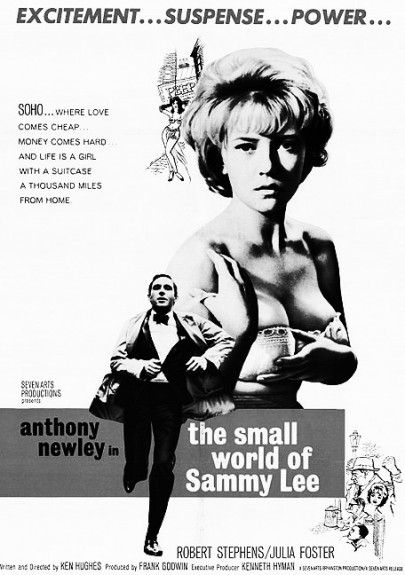 “SOHO… WHERE LOVE COMES CHEAP, MONEY COMES HARD AND LIFE IS A GIRL WITH A SUITCASE A THOUSAND MILES FROM HOME.”
“SOHO… WHERE LOVE COMES CHEAP, MONEY COMES HARD AND LIFE IS A GIRL WITH A SUITCASE A THOUSAND MILES FROM HOME.”Part of a somewhat tiny genre of British films set in amongst the vice, nightlife and shennanigans of just-pre-swinging London/Soho; alongside The World Ten Times Over, Saturday Night Out and Jungle Street but I expect… well, no, not expect… this is the top of the heap.
As a certain gent once said to me about it “Sometimes they just get it right”.
It’s also a lovely document of the streets from that time (and it’s interesting seeing how until at least relatively recently they haven’t changed all that much)… stars a future Steptoe as Mr Tony Newley’s helper and also a future nurse Gladys Emmanuel as a showgirl.
Lovely stuff indeed.
I seem to remember making a special trip a fair few miles to see it at the BFI… and of course it then finally appeared on an official shiny disc release. Ah well, well worth it.
The soundtrack has relatively recently been sent out into the world by cultural curator Mr Jonny Trunk.
One of the places I first came across the film can be found at Cinedelica. Scribing on Sammy’s trial and tribulations by Lady Of Noir Ms Cathi Unsworth at appropriately enough 3:AM Magazine.
Peruse the London Collection including Mr Sammy Lee here.
continue reading -
Saturday Night, Sunday Morning and a somewhat classy pictorial representation of Jack The Lad…
 And while we are talking about classic British 1960s kitchen sink drama and “A kind of drab (or should that be against a drab world/setting?), suited and booted, beehived and bouffanted glamour, charisma, style and working class rebellion” and “a certain kind of rough hewn, no mucking about masculinity” mixed in with that and more than a touch of solid, glowering male-ness, alongside a just pre-Swinging London kicking against it all (see here)…
And while we are talking about classic British 1960s kitchen sink drama and “A kind of drab (or should that be against a drab world/setting?), suited and booted, beehived and bouffanted glamour, charisma, style and working class rebellion” and “a certain kind of rough hewn, no mucking about masculinity” mixed in with that and more than a touch of solid, glowering male-ness, alongside a just pre-Swinging London kicking against it all (see here)……well, it wouldn’t be quite right to not mention Albert Finney In Saturday Night and Sunday Morning.
In the photograph above he tends to remind me of an early 1960s “angry young man” meets an iconic Wild Western frontier kind of chap.
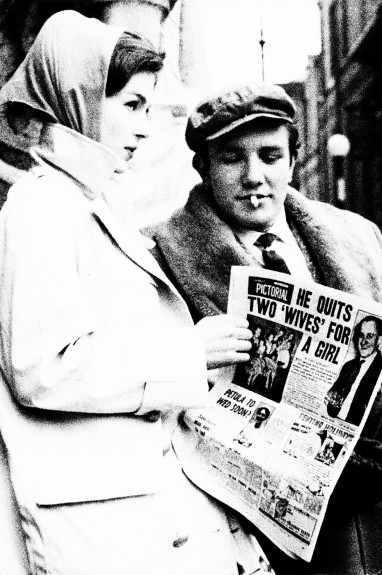 And maybe there’s something in that as this was a time when new frontiers were opening up (sometimes only relatively briefly) and one of those frontiers could be seen to be life outside the metropolis represented cinematically in British kitchen sink films.
And maybe there’s something in that as this was a time when new frontiers were opening up (sometimes only relatively briefly) and one of those frontiers could be seen to be life outside the metropolis represented cinematically in British kitchen sink films.If there was one of those new(ish) fangled online encyclopedia pages for the above paragraph, I expect they could just put a photograph of Mr Finney in the adaptation of Mr Sillitoe’s book with a note saying “See image above.”
Along which lines, I think I shall let the images speak for themselves.
 Well, almost, apart from to say has there ever been a finer book cover than the film tie-in to Saturday Night and Sunday Morning? I’m not sure I’ve seen one. It’s always cheers the day up when I see a copy in a charity shop (and I have to restrain myself from not buying it again just because, well, it’s always worth buying).
Well, almost, apart from to say has there ever been a finer book cover than the film tie-in to Saturday Night and Sunday Morning? I’m not sure I’ve seen one. It’s always cheers the day up when I see a copy in a charity shop (and I have to restrain myself from not buying it again just because, well, it’s always worth buying).Classic period pulp fiction-esque painting style that has wandered off to a particularly classy slice of British northern/midlands cinematically realised social realism and iconography.
Lovely stuff.
continue reading -
Expresso Bongo and a surprising Soho Johnny
 “SOHO JOHNNY NEVER HAD IT SO GOOD OR LOST IT SO FAST”
“SOHO JOHNNY NEVER HAD IT SO GOOD OR LOST IT SO FAST”Well, I never really thought I would watch a Cliff Richard film and think “That’s kind of quite decent actually”.
Expresso Bongo is the 1959 (almost) film debut by Mr Richard and is the celluloid adaptation of the West End musical.
At points it wanders into not-so-decent more mainstream cheese and even exploitation but and although it’s no Small World of Sammy Lee (see Day #7/365a), nor a World Ten Times Over or even a Beat Girl, it’s actually a rather decent capturing of that just pre-swinging London and Soho period that I have something of a soft spot for.
Although it doesn’t necessarily have Sammy Lee’s inherent grit/edge, if memory serves correctly it does share some kind of sense of Soho hustle and basement showgirl-ness.
The book was written by Wolf Mankowitz – who also appears in the film credits as a sandwich board man that announces his own credit… which is a nice touch and along with a few others, such as the pin-up girl stage curtains, makes the film at the very least an interesting curiousity.
The film was directed by Val Guest, whose work has made an appearance around these parts before – see Hell Is A City at Day #21/365a – and who was also responsible for the somewhat classic and Flaming Stars song title lending The Day The Earth Caught Fire (and by the 1970s, like much of the UK film industry he had wandered into British smut comedies such as Au Pair Girls and Confessions Of A Window Cleaner).
Places to wander to:
Further Expresso Bongo Soho/London location shots.
Wolf Mankowitz’s novelisation.
Expresso Bongo’s opening credits – a nice snapshot of a certain time and place.Peruse the film here.
continue reading -
The Flipside, West End Jungle, interrelated film cycles and cultural rehabilitation
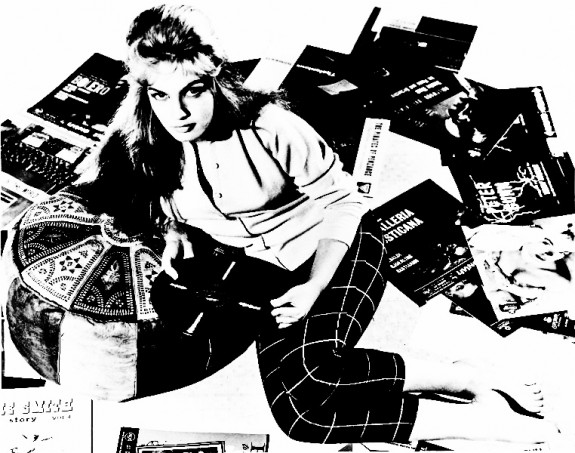
I wa recently been nattering about a loose cycle of just pre-Swinging London Soho shennanigan films and The World Ten Times Over.In an interconnected manner, during that film, in a meta fictional/blurring of the boundaries between fiction and faction manner, is a scene where a poster for the then banned documentary West End Jungle can be seen.

West End Jungle purports to be an overview of the worlds, culture and lives that the above cycle of films inhabit but was in fact an exploitational staging of such things. It is part of a loose film cycle largely by director/producer Arnold Miller that would lead to future salacious sometimes partly-non-documentaries such as London In The Raw and Primitive London, both of which have been rescued / rehabilitated and gained an air of academic respectability by their relatively recently release, brush and scrub up by the BFI.
It is part of a loose film cycle largely by director/producer Arnold Miller that would lead to future salacious sometimes partly-non-documentaries such as London In The Raw and Primitive London, both of which have been rescued / rehabilitated and gained an air of academic respectability by their relatively recently release, brush and scrub up by the BFI.This rescue and rehibilitation is something that as I type is a process that is also being undergone by the Soho shennanigan film cycle titles Expresso Bongo and Beat Girl, as part of the BFI’s Flipside film release on DVD/Bluray and latterly internet label.
The Flipside is described by the BFI as:
“BFI Flipside is dedicated to rediscovering cult British films, reclaiming a space for forgotten British films and filmmakers who would otherwise be in danger of disappearing from our screens forever.”
When it was first inaugurated London In The Raw and Primitive London were two of their first releases and it felt like the label had been set up just for me; a sort of classy trawling of the underbelly and neglected undercurrents of film.
 The films that have been released are often more cultural curios than those that could be considered cinematic classics but none the less worthwhile for that.
The films that have been released are often more cultural curios than those that could be considered cinematic classics but none the less worthwhile for that.If you were to imagine a very selectively done Something Weird Video with institutional status, public funding, a tendency to wander towards an almost Derek Jarman-esque/arthouse take on what constitutes mondo film, a touch more prudish or possibly jurisprudent take on such things than say Something Weird, high end reproduction and releasing, well you could well be heading in the right direction.
Peruse the Flipside releases here. Possibly discover related events that leave you slightly frustrated at not being able to go to them/having missed them here.
PS Is it just me or does the publicity photograph of Gillian Hills from Beat Girl above seem like something of a predecessor to Mr Vince Ray’s Death Of The Teenage Death Song work?
continue reading -
A gathering of a Soho film cycle
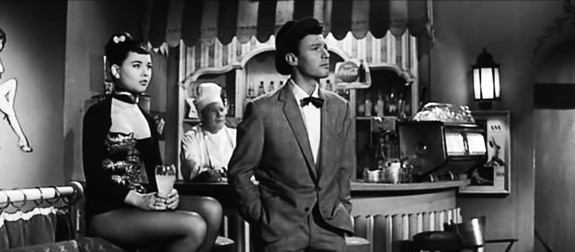
I was recently nattering about The World Ten Times Over, which seems to be part of a loose cycle of British films from around the late 1950s to about 1963 (or, as I’m fond of saying around these parts, just pre-Swinging London); tales of life lived but a few steps away from the gutter in London’s Soho and heart of the town nightlife, often set in and around hostess bars / clip joints and the shennanigans, ducking and diving that such ways of life can involve.As with The World Ten Times Over these are all films that could each be described as “a curiousity, a snapshot of a particular way of life and a transitional point in life and culture – post-war auserity about to make way for the colour, spark and vitality of first Swinging London and pop-art mod(ernisms) and later the evolutions and looseness of psychedelia and what has come to be labelled hippie-dom.”
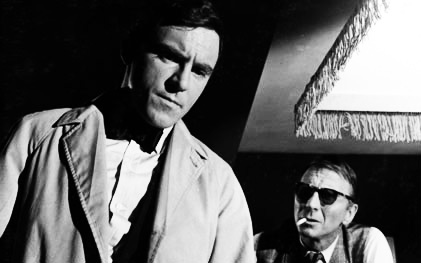 Along which lines, I thought now would be a good point to gather what for my good self are the particular touchstones / reference point films for such things:
Along which lines, I thought now would be a good point to gather what for my good self are the particular touchstones / reference point films for such things:This is a film cycle that could well include the surprising Soho Johnny of Expresso Bongo, the almost Arthur Seaton down-to-earth night out but in Soho-isms of Saturday Night Out, in a more teenage-kicks Bohemian coffee bar manner Beat Girl, the slightly earlier tabloid-esque scares of The Flesh Is Weak, the quota quickie feeling Jungle Girl, the blonde bombshell from over the seas Too Hot To Handle and for myself the somewhat fine grandfather of them all The Small World Of Sammy Lee.
I could possibly include the pre-Steptoe Harry H. Corbett featuring Cover Girl Killer. Released in 1959, it feels like it belongs to a much earlier era. It also has that quota quickie feel but also that curiously clipped older British film sense to it – a past far, far away from modern mores and modes.
Or the also slightly later 1964 Harry H. Corbett featuring Rattle Of A Simple Man, where he plays a Northern innocent lost in Soho who meets a hostess, spends the night with but not in the manner which might be expected.
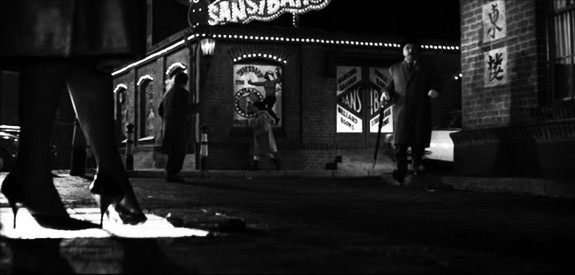
And in a further over the seas the imagined / reimagined Soho of Das Phantom Von Soho could well belong loosely to this cycle. One thing that is curious about many of these films is that despite their tabloid friendly subject matter, this can sometimes mask much more human stories than their subject matter and setting might imply and they are not always or just salacious exploitation films; The World Ten Times Over is a gritty realist film with a sense of the consideration of the futilities of life, Rattle Of A Simple Man is actually quite a sweet, touching story of romance rather than times in “London’s sin-filled strip” and The Small World Of Sammy Lee is, well, just mighty fine cinema that takes in realism, thriller, love and loss in this particular heart of London.
One thing that is curious about many of these films is that despite their tabloid friendly subject matter, this can sometimes mask much more human stories than their subject matter and setting might imply and they are not always or just salacious exploitation films; The World Ten Times Over is a gritty realist film with a sense of the consideration of the futilities of life, Rattle Of A Simple Man is actually quite a sweet, touching story of romance rather than times in “London’s sin-filled strip” and The Small World Of Sammy Lee is, well, just mighty fine cinema that takes in realism, thriller, love and loss in this particular heart of London.
continue reading -
Bettie Page and transgressive reverberations
This photograph/image of Bettie Page for a long time was something of a favourite. It’s Ms Page at her finest, feisty attitude-ness.
Back a fair few years before vintage and retro were mainstream cultural reference points and when the zeros and ones easy access of the internet was still in its infancy, I bought a photographic grade reproduction of the cover from a, well, vintage clothing stall.
For a long time I didn’t know any more about it other than the image itself – what the magazine was etc and due to the relative scarcity of cultural distribution at the time, that’s the way it stayed.
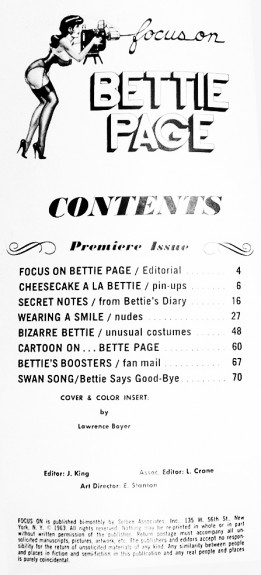 As an aside and now, due to the nolonger infancy of the internet I know that it’s the cover to a particularly scare 72 page magazine on Ms Page from 1963 (ah that year again, just as change began to gather pace).
As an aside and now, due to the nolonger infancy of the internet I know that it’s the cover to a particularly scare 72 page magazine on Ms Page from 1963 (ah that year again, just as change began to gather pace).Apparently printed in only 1500 copies, it seems to be one of the higher priced Bettie Page items out in the world. I expect you’d need to pay around £300-500 for a copy nowadays. Blimey indeed.
Due in part to that scarcity it seemed like a rare and precious thing but looking at it now, it seems to be a particularly iconic picture of a particularly iconic model – a distilling or honing down of the bad girl side of Bettie Page’s often wholesome cheesecake pinup image, though without moving into her more overly and overtly defined festishistic imagery.
Yes, it’s off its age but it hasn’t gained an almost harmless twee-ness that some pinup imagery from the time has.
In fact, looking at it again recently, this seems like a world away from the girl next door depiction of Bettie Page – this is a much more harsh, fierce beauty and sexuality that seems to reverberate and even have some kind of transgressive or subversive underground quality to it even all these years later.
It is curious how from all the models who were working at that time, Bettie Page and the imagery created with/by her seems to be something of an island of such things.
continue reading -
A Kind Of Loving, suited and booted, beehived & bouffanted glamour and prime time kitchen sink-isms
 A bit like somehow or other 1970s grit along the lines of Villain is in amongst Afterhours and my own work, somewhere along the line could be found some kind of inkling of classic kitchen sink drama, cinema etc. Think Saturday Night, Sunday Morning, A Taste Of Honey etc.
A bit like somehow or other 1970s grit along the lines of Villain is in amongst Afterhours and my own work, somewhere along the line could be found some kind of inkling of classic kitchen sink drama, cinema etc. Think Saturday Night, Sunday Morning, A Taste Of Honey etc.It’s possibly in the very Britishness. A kind of drab (or should that be against a drab world/setting?), suited and booted, beehived and bouffanted glamour, charisma, style and working class rebellion that could be traced forwards to the likes of the Medway scene in the 1980s (Billy Childish, The Milkshakes etc). A certain kind of kicking back against how things are just before they’re ready to fully start changing and having a little give – ie just pre-swinging London-ness, as I have something of a fondness for. Possibly a certain kind of rough hewn, no mucking about masculinity mixed in with that just mentioned suited and booted style.
 Along which lines, the early 1980s television adaptation of A Kind Of Loving…
Along which lines, the early 1980s television adaptation of A Kind Of Loving…There’s a point in Tom Jones autobiography where one of his early managers sees him perform for the first time and afterwards his wife says something along the lines of “I’ve never seen anything so male.”
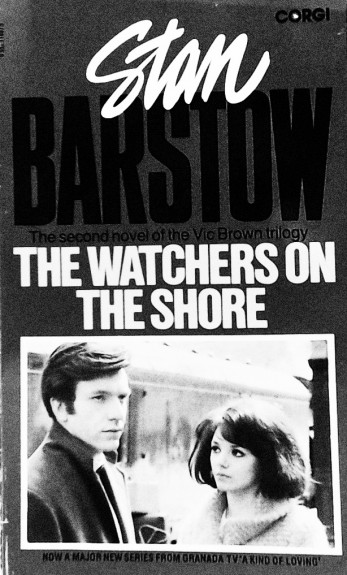 Clive Wood (seen to the left on the cover of one of the tv tie-in/follow up books) in this television version reminds me of that sense. There’s a very solid, almost glowering maleness to him.
Clive Wood (seen to the left on the cover of one of the tv tie-in/follow up books) in this television version reminds me of that sense. There’s a very solid, almost glowering maleness to him.And then wandering back to 1970s grit, mixing it in with 1960s kitchen sink drama (and because as I think I’ve said before, I have something of a fondness for how books, films etc are presented, postered, covered etc over the years)… the cover below is from around the mid-1960s, the style and cut of the clothes says that time but the setting and the cooling towers tends to make me think more of the early to mid-1970s, that sense of an industrial nation neglected, troubled, possibly gone to seed.
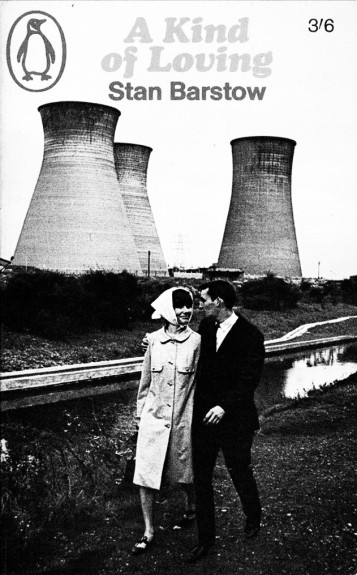 Oh and prime time kitchen sink? Well, the the A Kind Of Loving TV series was broadcast at a time when there were but three or so television channels in the UK and in that climate this particular slice of kitchen sink drama was only kept off the top viewing figures slot by the then most popular soap opera. 15 million folk turned on and tuned in, effectively heading towards a third of the population.
Oh and prime time kitchen sink? Well, the the A Kind Of Loving TV series was broadcast at a time when there were but three or so television channels in the UK and in that climate this particular slice of kitchen sink drama was only kept off the top viewing figures slot by the then most popular soap opera. 15 million folk turned on and tuned in, effectively heading towards a third of the population.
continue reading -
The Long Firm and a lovely bit of schmutter
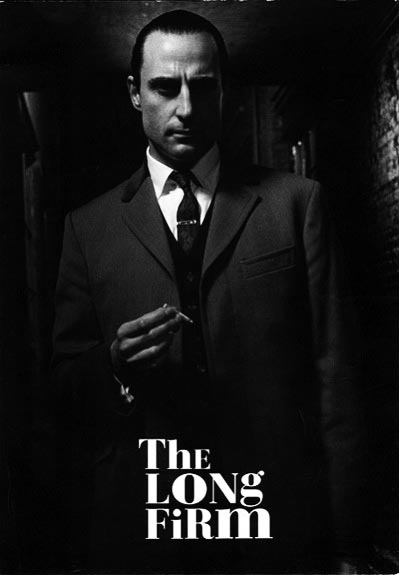 Here’s Mr Mark Strong in The Long Firm, wearing a lovely bit of schmutter.
Here’s Mr Mark Strong in The Long Firm, wearing a lovely bit of schmutter.The television adapatation of Jake Arnott’s The Long Firm, from 2004, is a fine piece of work – in fact the first three (of four) episodes are some of the best British television I’ve seen.
The series tells a set of stories concerning characters who are interlinked by their connection to Harry Starks – a gay “but not poofy” gangster who still adores a (now) broken Judy Garland and who is mired in his own personal and “work” problems that take in wayward lovers, corrupt Lords of the land, property deals gone bad…
The stories, as with much of Jake Arnott’s work, draw broadly from real life events and lives – the aforementioned past-her-peak Judy Garland, The Krays, Lord Boothby… but I think what it draws from mostly is the myth, glamour, corruption and stories of a London and Soho that is a character unto itself.
Ruby’s Story is a particular favourite, where Lena Headey plays a once minor film star, still all old school glamour in the face of the coming of swinging London and mini-skirt-ed upstarts. In it Ms Headey brings a swish and swirl of Diana Dors era style and a warm heart caught up in this appealing but actually very dark and hard world.
As an aside, below is the author of the original book, Mr Arnott, in a blink and you’ll miss him appearance during Ruby’s Story…
I think it would be fair to file The Long Firm alongside a set of films and television programs that have been pointers/touchstones for Afterhours Sleaze and Dignity in their representations of back-in-the-day Soho basement glamour (and grime); filed alongside suspects who are/no doubt will be familiar from around these parts The Small World Of Sammy Lee, The World Ten Times Over, Das Phantom Von Soho, Our Friends In The North etc.
Peruse the series here and the book
here.
continue reading -
Jurgen Vollmer’s Rockers and kitchen sink rock’n’roll
 The people/photographs in Jurgen Vollmer’s Rockers book (also released as Rock’n’Roll Times) could well be one of the original sources that Karlheinz Weinberger’s rock’n’roll took and reimagined into their own image of such things.
The people/photographs in Jurgen Vollmer’s Rockers book (also released as Rock’n’Roll Times) could well be one of the original sources that Karlheinz Weinberger’s rock’n’roll took and reimagined into their own image of such things.Vollmer’s photographs from the late 1950s/early 1960s (?) document young teenagers, rock’n’roll and early Beatle’s fans; their style being a subtle version of what we now think of as 1950s rock’n’roll / rockabilly, post the first swell of such things but pre the move towards a more 1960s, mod or Swinging London style.
I’ve lived with these photographs for a long time without realising it; they were used on the cover of The Smiths album The World Won’t Listen, which I bought many years ago when it very first wandered out into the world.
At the time I don’t think I really understood them. My cultural antennae were not necessarily yet well tuned towards recognising period detail and I think I may have thought they were just photographs of some young chaps on the cover and some young gals at the fair on the back.
 Looking at the photographs more recently I think they made more sense; the subtle turn of the decade rock’n’roll style is a somewhat Morrissey-esque, low key, kitchen sink friendly take on such things.
Looking at the photographs more recently I think they made more sense; the subtle turn of the decade rock’n’roll style is a somewhat Morrissey-esque, low key, kitchen sink friendly take on such things.More a once-Manchester-Northern-England-like cup of tea version of such things than the exotic, otherly flamboyance of say Elvis or Little Richard.
I’ve seen a few different versions of this book, some of which can be perused below:
Rock’n’Roll Times, Rock ‘N’ Roll Times: The Style and Spirit of the Early Beatles and Their First Fans
continue readingand Rockers.




